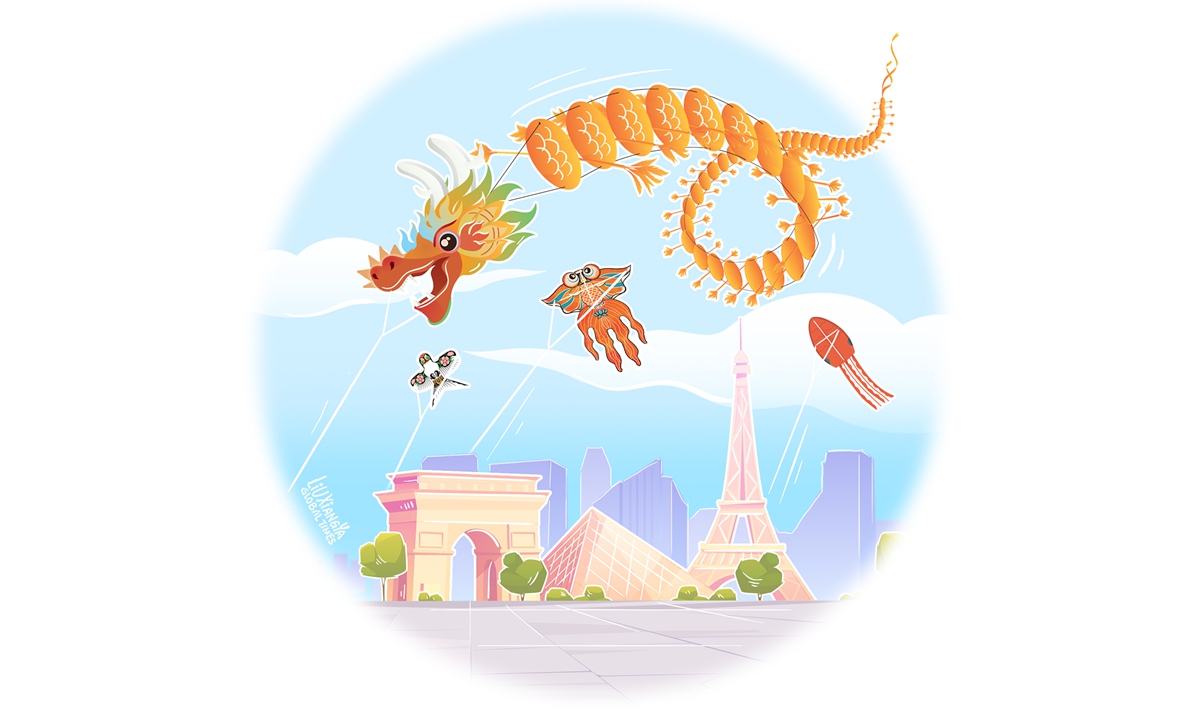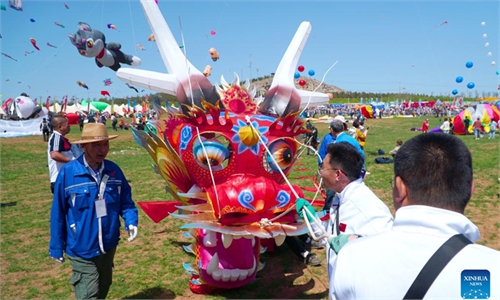ARTS / CULTURE & LEISURE
Flying kites transcend cultures, regions

Illustration: Liu Xiangya/GT
Kites, a kind of ancient handicraft deeply rooted in Chinese history, have evolved from a military tool to a traditional pastime toy and then into a potent symbol of culture. Flying kites embodies the human aspiration to explore the skies. This symbolic ascent captures more than just the physical flight; it reflects a broader connection to the cosmos that has captivated human imagination for millennia.
Throughout its history, the kite has transcended its original practical applications to become a medium to express artistic, cultural and even spiritual sentiments.
"Since ancient times, people have liked to fly kites during the spring. A kite soaring high up in the sky symbolizes people letting go of their worries, bad luck or any unhappiness from the past year. People on the ground are connected to the sky through the kite strings. Flying kites is more than a leisure activity but also embodies people's pursuit for a beautiful and happy life," said Wang Zhenhua, chairman of the Weifang Modern Kite Cooperative.
Today, the kite is not just a plaything but a channel for cultural exchanges and mutual understanding across borders. The recently concluded 41st Weifang International Kite Festival and the 2024 Weifang Kite Carnival held in Weifang, East China's Shandong Province, are a good illustration of this. The festival, a spectacle of color and creativity, has become a global hub for kite enthusiasts. This year, more than 460 participants from 46 countries and regions gathered in Weifang, illustrating the kite's role in bridging diverse cultures.
Khalil Hashmi, ambassador of Pakistan to China, gave a speech at the opening ceremony held on April 19, during which he called the Weifang International Kite Festival a global event to celebrate friendship, innovation and the joy of flying kites.
"The event has built bridges for promoting consensus and understanding, transcending national borders and fostering friendships. We will take this opportunity to further promote political, economic, and cultural exchanges between China, Weifang, and Pakistan, deepen mutual understanding, strengthen economic ties, and deepen friendship in promoting social development," said Hashmi.
At the festival, Ali West Hill from India told the Global Times that he has been flying kites for 15 years but this was his first time in Weifang, as well as his first time in China. He was very excited to see the country and experience a different culture through the festival.
Massimo from Italy, dressed in a shirt of vibrant colors and sporting dyed red, green and white hair, the colors of the Italian national flag, shared that through the kite festivals, he has forged lasting friendships with people from all around the world. While he was traveling in Europe shortly after participating the kite festival in Weifang, he ran into a friend he had just made at the festival.
"It is amazing that people can build connections within such a short period time through a shared hobby."
Kites have brought him to China several times. He went to Guangdong Province in South China around 20 years ago. His passion for kites has not only deepened his connection with Chinese culture but also offered him a front-row seat to witness China's rapid development.
The interaction at such festivals goes beyond mere cultural exhibition to facilitate deeper interpersonal and international relationships. For instance, the 37th International Kite Festival in Berck-sur-Mer, France, running from April 20 to 28, attracts many professionals and spectators. Weifang sent a delegation, including inheritors of intangible cultural heritage, to participate in this grand celebration. This delegation is not only flying kites but also showcasing other forms of Chinese intangible cultural heritage, such as woodblock printing, paper-cutting, and nut carving.
China was chosen as the guest country of honor. It's the first time that the festival has introduced the concept of guest countries since its establishment in 1987. The timing of this cultural exchange is symbolic. As China and France celebrate 60 years of diplomatic relations in 2024, the inclusion of kites in these celebrations adds a vibrant stroke to the narrative of China-France friendship. It underscores the shared values and mutual respect that have come to define this bilateral relationship.
The Magic of the Kite (1957) was the first feature film co-produced by a Chinese and foreign studio as well as the first color Chinese children's film made after the founding of the People's Republic of China in 1949. The film tells the story of the friendship between French and Chinese children made through flying kites. In 2019, a Chinese documentary based on the film was released to celebrate the 60th anniversary of the film's release in China and the cultural exchanges between the two countries.
"It can be said that the kite is a significant cultural symbol in the history of the friendship between China and France," Liu Hongge, director of the China Cultural Center in Paris, told the Global Times.
Kites serve as more than just objects of entertainment; they are emblems of countries shared cultural practices. They remind us of the universal human quest for freedom and creativity, transcending linguistic, geographical and cultural barriers.
As colorful kites dance in the sky, they weave together stories of past and present, of tradition and innovation, and of local identity and global community. International kite festivals, much like the string of a kite, tie us to each other, pulling us closer in a celebration of humanity's shared skies.
The author is a reporter with the Global Times. life@globaltimes.com.cn

